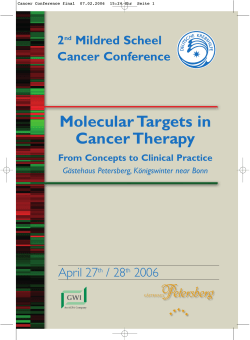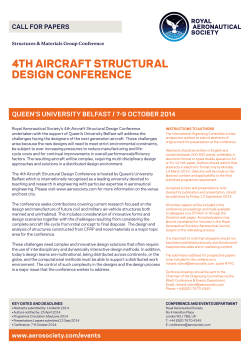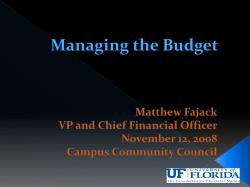
Federal Grants, Universities and the Academic Pipeline Coming Together CHEFS and ACE Conference
Federal Grants, Universities and the Academic Pipeline Coming Together CHEFS and ACE Conference Funded by the Alfred P. Sloan Foundation April 21, 2010 Mary Ann Mason, Marc Goulden, Karie Frasch University of California, Berkeley 1 Women as a Percent of Doctoral Recipients in the United States (U.S. Citizens Only), Sciences, 1966-2006 Engineering Life Sciences Physical Sc. Social Sc. Geoscience Psychology Math/Comp. Sc. 80% 70% 60% 50% 40% 30% 20% 10% 200 06 200 04 200 02 200 00 199 98 199 96 199 94 199 92 199 90 198 88 198 86 198 84 198 82 198 80 197 78 197 76 197 74 197 72 197 70 196 68 196 66 0% 2 Source: National Science Foundation (NSF), Survey of Earned Doctorates, retrieved from WebCaspar, 4/15/2009. Problems in the Pipeline: Women as a Percent of NIH and NSF Awards*, by Level of Award (2007) NIH NSF 70% 60% 50% 63% 54% 40% 44% 42% 30% 25% 20% 23% 10% 0% Pre-Doctoral Post-Doctoral* Junior Faculty Competitive F Faculty lt Awards A d Source: NIH and NSF Accountability Reports, 2008. * The postdoctoral award information for NSF is missing significant data (39% of awards were to women, 47% to men, and 14% of the sample was unknown in 2007). We chose not to include the data point because it is not comparable to 3 the others. Source: Fae Korsmo, Senior Advisor, Office of the Director, NSF. Heads and Necks of Science PhD Recipients* Women, W Early Babies Tenured Professors Women, W Late or No Babies Men, M Early Babies 53% 65% 77% 47% 35% 23% N=2848 N=3057 N=13058 Second Tier Part-Time, 2-Year Faculty, Non-Ten. Non Ten. Track, Acad. Researchers, and Still Tenure Track *PhDs from 1978-1984 Who Are Working in Academia 12 to 14 Years Out from PhD Source: Survey of Doctorate Recipients. Sciences, 1979-1999. Note: The use of NSF Data does not imply the endorsement of research methods or conclusions contained in this report. 4 Family Status of Tenured Faculty in the Sciences* Women Men Married without Children 14% Single with Children** 8% Married with Children** 53% Single without Children 25% N 3109 N=3109 Single with Children** 4% Married without Children 14% Married with Children** 73% Single without Children 9% N 19 074 N=19,074 *PhDs from 1978-1984 Who Are Tenured 12 Years out from PhD in STEM & Bio. Sciences. **Had a child in the household at any point post PhD to 12 years out. Source: Survey of Doctorate Recipients. Sciences, 1979-1999. Note: The use of NSF Data does not imply the endorsement of research methods or conclusions contained in this report. 5 Leaks in the Pipeline to Tenure for Women PhDs in the Sciences* Entering a t tenure track t k Position PhD receipt Achieving tenure Women PhDs water level Women PhDs water level Married women with young children •35% lower odds than married men with young children to get a tenure-track position •28% lower than married women without young children •33% lower than single women without young children Married women without young children •8% lower odds than married men without young children to get a tenure-track position •10% lower than single women without young children Married women with young children •27% lower odds than married men with young children to become tenured •13% lower than married women without young children •4% lower than single women without young children *Results are based on survival analysis of the Survey of Doctorate Recipients (a national biennial longitudinal data set funded by the National Science Foundation and others, 1981 to 2003) in all sciences, including social sciences. The analysis takes into account discipline, age, ethnicity, PhD calendar year, time-to-PhD degree, and National Research Council academic reputation rankings of PhD program effects. For each event (PhD to TT job procurement, or TT job to tenure), data are limited to a maximum of 16 years. The waterline is an artistic rendering of the statistical effects of family and gender. Note: The use of NSF Data does not imply the endorsement of research methods or conclusions contained in this 6 report. Person-year N for entering tenure track=140,275. Person-year N for achieving tenure=46,883. Career Goal at Start of PhD Bus., M Men *Professor w. Research Emphasis Current Goal Gov., Gov Other 37% M Men Prof. (rsrch)* 45% Prof. P f (teach) Other Acad. 15% Prof. (teach) 17% 3% N 3067 N=3067 Other Acad. 2% Career Goal at Start of PhD Women Prof. Prof (rsrch)* 34% Bus., Gov., Other 48% N 3033 N=3033 Current Goal Bus., Gov., Other 36% Other Acad. 4% Changing Career Goals Women Prof. (rsrch)* 38% Prof. (teach) 22% UC PhD Students: Sciences* N=2816 Bus., Gov., Other 49% *Phys., Bio., & Soc. Sc. Prof. P f (rsrch)* 25% Prof. (teach) 21% N=2769 Other Acad. 5% 7 Source: Mason, Mary Ann and Marc Goulden. 2006. “UC Doctoral Student Career Life Survey.” (http://ucfamilyedge.berkeley.edu/grad%20life%20survey.html). Reasons Most Commonly Cited by UC PhD Students in the Sciences* for Shifting Career Goal away from Professor with Research Emphasis % Citing Factor As “Very Very Important**” Important in Career Goal Shift Total Men Women 1 Negative experience as PhD student 44% 44% 45% 2 Other life interests 42% 35% 48% 3 Professional activ. too time consuming 41% 35% 47% 4 Issues related to children 34% 20% 44% 5 Geographic location Issues 33% 27% 37% 6 Feelings of isolat./alienation as PhD stud. 31% 30% 31% 7 Career advancement issues 30% 33% 27% 8 Job security 28% 28% 28% 9 Bad job market 27% 27% 27% 10 Monetary compensation (e.g. salary, ben.) 26% 31% 22% 11 Spouse/partner issues or desire to marry 26% 21% 29% 12 Other career interests 24% 22% 26% *Phys., Bio., & Soc. Sc. **Not applicable is excluded from analysis. N=797 to 1006 358 to 475 435 to 526 Yellow shading indicates the group’s response is significantly higher than the other group’s response (P<.01). 8 Source: Mason, Mary Ann and Marc Goulden. 2006. “UC Doctoral Student Career Life Survey.” (http://ucfamilyedge.berkeley.edu/grad%20life%20survey.html). Shifting Goal away from Professor with Research Emphasis: Selected Quality-of-Life Related Explanations by UCB Men & Women Doctoral Students •“I feel unwilling to sacrifice a healthy family life and satisfying personal life to succeed in academics, and thus industrial options have become more appealing.” pp g •“Fed up with narrow-mindedness of supposedly intelligent people who are largely workaholic and expect others to be so as well.” •“I look at the lives of the professors I see every day, and I want to emulate none off them.” •“I really want to be a mom. This seems like an extremely difficult goal to align with the goal of being a faculty member at a top university in engineering.” i i ” •“Since beginning my doctoral work, I have become convinced that very few, if any, female professors are able to have stable, fulfilling family lives of the sort that I wish for (a stable marriage and children). children) ” •“Academia is not very supportive of women. There are challenges at every step of the way in terms of having to make choices. I want to be able to have a family, have children and enjoy being a mother and wife which are close to impossible when one chooses academia. The clock is ticking and it does not stop for anything or anyone.” 9 Source: Mason, Mary Ann and Marc Goulden. 2006. “UC Doctoral Student Career Life Survey.” (http://ucfamilyedge.berkeley.edu/grad%20life%20survey.html). Career Goal at Start of PhD N=62 M Men Current Goal N=62 M Men *Professor w. Research Emphasis Career Goal at Start of PhD Women Changing Career Goals N=45 Current Goal N=45 Women UC PhD Students: New Parents Paid Off Federal Grants at Birth/Adopt. 10 Source: Mason, Mary Ann and Marc Goulden. 2006. “UC Doctoral Student Career Life Survey.” (http://ucfamilyedge.berkeley.edu/grad%20life%20survey.html). Career Goal at Pdoc Start M Men Current Goal Bus., Gov., Other 19% Other Acad. 7% Prof. (teach) 5% Prof. ( (rsrch)* h)* 69% *Professor w. Research Emphasis Prof. (teach) 6% Other Acad. 7% Prof. (rsrch)* 58% N 1271 N=1271 Career Goal at Pdoc Start Women M Men Bus., Gov., Oth Other 29% N 1269 N=1269 Current Goal Bus., Gov Gov., Other 25% Other Acad. 11% Changing Ch i Career Goals Prof. (teach) 8% Women Prof. (rsrch)* 56% UC Postdocs N=921 Bus., Gov., Other 36% Other Acad. 11% Prof. (rsrch)* 43% Prof. (teach) 10% N=915 Source: Mason, Mary Ann, Marc Goulden, and Karie Frasch. 2008. “UC Postdoctoral Career Life Survey.” (http://ucfamilyedge.berkeley.edu/grad%20life%20survey.html). 11 Shifting Career Goal away from Professor with Research Emphasis: UC Postdoctoral Scholars, by Gender and Family Status/Future Plans Women N= Men 19% No children, no future plans 172 101 20% No children, f t future plans l to t have children 17% 394 260 28% 19% previous Children p to postdoc 155 62 32% 20% New children since postdoc 123 56 41% 0% 10% 20% 30% 40% 50% Percent of Postdocs with Professor with Research Emphasis Goal at Start Who Shifted Career Goal to Another by Time of Survey Source: Mason, Mary Ann, Marc Goulden, and Karie Frasch. 2008. “UC Postdoctoral Career Life Survey.” (http://ucfamilyedge.berkeley.edu/grad%20life%20survey.html). 12 Provision of Paid Maternity Leave for Academic Populations at Association of American Universities (AAU) (62 total) % of AAU institutions Black = Entitlement to at least 6 weeks of paid leave. Blue = Limitations to paid leave (e.g., only for particular groups, partial pay, less than 6 q for previous p service time, etc.). ) weeks, requirements Turquoise = Paid leave depends on sick and/or vacation leave accruals. Lighter Blue = Delay in availability of sick and/or vacation leave accruals, ie., FMLA. Lightest Blue = Less, ad hoc, or no paid leave available. 13 Source: Mason, Mary Ann, Marc Goulden, and Karie Frasch. 2008. “Family Accommodation Policies for Researchers at AAU Universities Survey.” Provision of Paid Parental Leave for Academic Populations at Association of American Universities (AAU) (62 total) % of AAU institutions Black = Entitlement to at least 1 week of paid leave. Blue = Limitations to paid leave (e.g., only available to primary caregiver, only for particular groups, g p partial p pay, p y requirements q for previous p service time, etc.). ) Turquoise = Paid leave depends on sick and/or vacation leave accruals. Lighter Blue = Delay in availability of sick and/or vacation leave accruals, ie., FMLA. Lightest Blue = Less, ad hoc, or no paid leave available. 14 Source: Mason, Mary Ann, Marc Goulden, and Karie Frasch. 2008. “Family Accommodation Policies for Researchers at AAU Universities Survey.” Title IX: Pregnancy & Family Status Discrimination “No p person in the United States shall,, on the basis of sex,, be excluded from participation in, be denied the benefits of, or be subjected to discrimination under any education program or activity receiving Federal financial assistance.”1 ((a)) General. A recipient p shall not apply pp y any y policy p y or take any y employment p y action: (1) Concerning the potential marital, parental, or family status of an employee. . . which treats persons differently on the basis of sex; or (2) Which is based upon whether an employee or applicant for employment is the head of household or p principal p wage g earner in such employee's p y or applicant's pp family y unit. (b) Pregnancy. A recipient shall not discriminate against or exclude from employment any employee or applicant for employment on the basis of pregnancy, childbirth, false pregnancy, termination of pregnancy, or recovery therefrom. ... (d) Pregnancy leave. In the case of a recipient which does not maintain a leave policy for its employees, or in the case of an employee with insufficient leave or accrued employment time to qualify for leave under such a policy, a recipient shall treat pregnancy, childbirth, false pregnancy, pregnancy termination of pregnancy and recovery therefrom as a justification for a leave of absence without pay for a reasonable period of time, at the conclusion of which the employee shall be reinstated to the status which she held when the leave began or to a comparable position, without decrease in rate of compensation or loss of promotional opportunities, or any other right or privilege of employment.2 1 2 20 U.S.C. § 1681. 45 C.F.R. 618.530 (National Science Foundation); 45 CFR 86.57 (Department of Health and Human Services, including the National Institutes of Health); 10 CFR 1040.53; (Department of Energy). 15 AAU Survey: Examples of Family Responsive Policies, Benefits, & Resources • Time-based policies/benefits (and associated review criteria) – – – – – – • Childcare – – – – • On and off-campus centers Subsidies Referral services Emergency backup Monetary supplements/benefits – – – – • Stopping the clock/extension of acad. progress timelines & funding Reentry rights Flex time and flexible scheduling Part Time/Unpaid Leaves Modified Duties S Sabbaticals and Leave off Absence Tuition remission Health care, continued coverage, and dependent healthcare Dependent care expenses (pretax) and dependent care travel funds Adoption reimbursement Other resources: Lactation rooms, family housing, caregiver groups, resources lists, etc. 16 Source: Mason, Mary Ann, Marc Goulden, and Karie Frasch. 2008. “Family Accommodation Policies for Researchers at AAU Universities Survey.” Possible Family Friendly Offerings by Federal Agencies to Support Researchers Paid Off of Grants/Contracts and PIs Possible Offering 14 12 8 6 4 USDA USAID NEH Comm. DoD DOE NSF NIH 0 Educ. 2 NASA Number of family frien ndly offerings 10 Source: Mason, Goulden, Frasch. 2009 .“Federal Agencies Survey.” # offer ff 1. No-Cost Extensions 8 2. Supplements to support family accommodations 3 3. Gender equity workshops 3 4. Formalized agency policy or statement supporting women in the academic pipeline 2 5. Part-time effort on fellowship or grant to accommodate family caregiving needs 2 6. Extend fellowship period for caregiving 2 7. Defer start of fellowship period for caregiving 1 8. Website(s) with clear information on support for family accommodations 1 9. Clear policy expectations for various classes of researchers (ie., not ad hoc) 1 10. Allow dependent care expenses to be charged to grants for conferences or meetings 1 11. Re-entry grants for those who have stopped out for family caregiving needs 1 12. Discount caregiving gaps in grant reviews 0 13. Provide instructions to peer reviewers on family accommodations 0 14. Data collection on gender and family status 170 Possible Policy Recommendations 1 Promote clear 1. clear, well well-communicated, communicated base-line base line family accommodation policies for all classes or researchers. • Federal Agencies can play a role in this by setting clear policies for various classes of researchers (e.g. NIH Kirchstein Fellows). • Universities can be more proactive (draw on best practices). 2. Provide Federal Agency or University supplements to offset family event productivity loss and help PIs. • Use some stimulus money or other sources to fund supplements. • Explore funding models: University direct costs vs. indirect costs. 3. Collaboratively, move toward a full package of family friendly policies/resources li i / that th t take t k into i t accountt the th career/family /f il life-course. lif 4. Remove time-based criteria for fellowships and productivity assessments that does not acknowledge in a meaningful way family e ents and their impact on career timing (start and end dates) events dates). • Discount resume gaps due to family issues. • Provide relevant instructions to peer reviewers. 5 Collect and analyze the necessary data to assure Title IX compliance and 5. assess the efficacy of existing and future policy initiatives. 18 Spring 2009 Men Spring 2003 1 Child 17% No Children 61% No Children 41% 2 Children 12% 3+ Children 10% Men 2 Children 29% # of Children, UCB Assistant Profess Profess. N=58 Spring 2003 1 Child 15% 2 Children 7% 3+ Children 5% No Children 73% N=41 1 Child 27% 3 Children 3% N=70 Spring 2009 No Children 36% 1 Child 43% 2 Children 21% Women N=56 Sources: “UC Berkeley Faculty Climate Survey,” 2003; “UC Berkeley Faculty Climate Survey,” 2009. N=67 19
© Copyright 2025





















